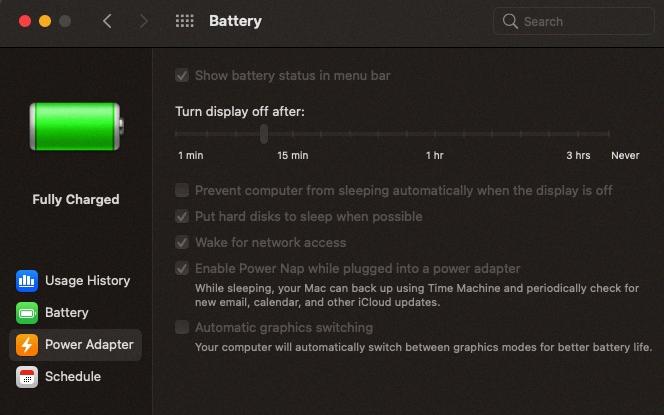Having a fully functional battery is crucial for the smooth operation of your Mac. However, sometimes Mac users may encounter issues with their battery settings being greyed out, preventing them from making necessary adjustments. In this article, we will explore the possible causes behind this problem and provide some solutions to resolve it.
Reasons for Battery Settings Greyed Out:
1. Screen Time Restrictions:
One possible cause for the battery settings being greyed out on your Mac is the presence of Screen Time restrictions. To check this, go to System Preferences and select Screen Time. Look for any restrictions in the App Limits and Content & Privacy sections that might be blocking your ability to edit the battery settings.
2. File Transfer Interruption:
Another reason behind the greyed-out battery settings could be an interrupted file transfer process. If you were in the middle of copying a folder from one drive to another and the process got halted, it might have caused this issue. Ensure that all drives are properly connected and try again to see if the problem persists.
3. Battery Removal:
If your Mac has a removable battery, it is possible that a disconnection or problem with the battery might lead to the battery settings being greyed out. In such cases, you can try the following steps:
A. Shut down your Mac.
B. Remove the battery. If you are unsure how to do this, contact an Apple Authorized Service Provider or Apple Retail Store for assistance.
C. Press and hold the power button for 5 seconds.
D. Reinstall the battery.
E. Press the power button again to turn on your Mac and check if the battery settings are accessible now.
Experiencing greyed-out battery settings on your Mac can be frustrating, but by following the steps mentioned in this article, you can troubleshoot and resolve the issue. Whether it’s due to Screen Time restrictions, interrupted file transfers, or battery-related problems, these solutions should help you regain control over your battery settings. Remember to seek professional assistance if needed, and always ensure that your Mac’s battery is functioning properly for optimal performance.
Why Are Your Battery Settings Greyed Out On Your Mac?
There are several reasons why your battery settings may be greyed out on your Mac. Here are some possible causes:
1. Software Update: Ensure that your Mac is running the latest version of macOS. Sometimes, outdated software can cause certain settings to become unavailable or disabled.
2. System Integrity Protection (SIP): SIP is a security feature in macOS that protects critical system files and prevents unauthorized modifications. If SIP is enabled, it can restrict access to certain settings, including battery settings. You can check if SIP is enabled by restarting your Mac and holding down Command+R until the Apple logo appears. Then, go to Utilities > Terminal and type “csrutil status” to see if SIP is enabled.
3. Screen Time Restrictions: If you have enabled Screen Time on your Mac, it may have restrictions in place that prevent you from editing the battery settings. Go to System Preferences > Screen Time and check the App Limits and Content & Privacy sections for any restrictions that might be blocking your ability to edit the battery settings.
4. User Account Permissions: Ensure that you have administrative privileges on your user account. Only users with administrative access can make changes to certain system settings, including battery settings. You can check your user account privileges by going to System Preferences > Users & Groups and selecting your user account. Make sure it is set as an administrator.
5. Hardware Issues: In some cases, battery settings may be greyed out due to hardware issues with your Mac. If none of the above solutions work, it is recommended to contact Apple Support or visit an authorized service provider to diagnose and fix any potential hardware problems.
By considering these possible causes, you can troubleshoot and resolve the issue of battery settings being greyed out on your Mac.

Why Won’t Your Mac Let You Show Battery Status?
There could be several reasons why your Mac won’t let you show the battery status in the menu bar. Here are a few possible explanations:
1. Older Mac model: If you have an older Mac model, it’s possible that the option to show the battery status in the menu bar is not available. Some older models may not support this feature.
2. System settings: It’s important to check your system settings to ensure that the battery status option is enabled. To do this, go to Apple menu > System Preferences, then click on “Dock & Menu Bar” or “Energy Saver.” Look for the option to show the battery status in the menu bar and make sure it is turned on.
3. Software issues: Sometimes, software issues can prevent the battery status from being displayed in the menu bar. In such cases, it may help to reset the System Management Controller (SMC) on your Mac. The SMC controls various hardware functions, including power management. Instructions on how to reset the SMC can vary depending on your Mac model, so it’s best to refer to Apple’s support documentation or contact Apple Support for assistance.
4. Third-party software conflicts: If you have any third-party software installed on your Mac that modifies the menu bar or power settings, it’s possible that it could be conflicting with the battery status feature. Try disabling or uninstalling any such software to see if it resolves the issue.
5. Hardware issues: In rare cases, there may be a hardware issue with your Mac’s battery or power management system that is preventing the battery status from being displayed. If you’ve tried all the above steps and are still unable to show the battery status, it may be worth contacting Apple Support or visiting an authorized service provider to have your Mac checked.
Why Are Things Greyed Out On Mac?
There are several reasons why files or folders may appear greyed out on a Mac. Here are some possible explanations:
1. Incompatible or unsupported file format: If you encounter greyed out files, it could be due to the file format not being supported by the application you are using to open them. Some apps may only work with specific file types, so make sure you have the appropriate software installed.
2. File permissions: Mac OS has a permission system that controls access to files and folders. If the file permissions are set to restrict access, the files may appear greyed out. To resolve this, you can try changing the permissions or taking ownership of the files.
3. File or folder is locked: It is possible that the file or folder has been intentionally locked, preventing any modifications. This is often done to protect important system files from accidental deletion or modification. To unlock the file, you can right-click on it, select “Get Info,” and uncheck the “Locked” checkbox.
4. File or folder is in a read-only location: If the file is located in a read-only location, such as a system folder, it may be greyed out. In this case, you may need to copy the file to a different location where you have write access.
5. File corruption or system error: If a file becomes corrupted or there is a system error, it may appear greyed out. In some cases, the file may be damaged beyond repair. You can try restarting your Mac or running disk utility to check for any disk errors.
6. File is currently in use: If a file is currently being accessed or used by another application, it may appear greyed out. Make sure to close any applications that might be using the file and try again.
7. File or folder is being synced or uploaded: If you use cloud storage services such as iCloud or Dropbox, files and folders that are being synced or uploaded may temporarily appear greyed out. This indicates that the syncing process is in progress.
If none of these solutions resolve the issue, it is possible that there may be a more complex technical problem with your Mac. In such cases, it may be helpful to consult with a professional or contact Apple Support for further assistance.
How to Reset Your Mac Battery?
To reset the battery on your Mac, follow these steps:
1. Make sure your Mac is turned off. If it’s currently running, shut it down properly.
2. Locate the battery on your Mac. If you’re unsure where it is, consult the user manual or contact Apple for assistance.
3. Carefully remove the battery from your Mac. Take your time and be gentle to avoid any damage.
4. If you’re unsure how to remove the battery, it’s recommended to seek help from an Apple Authorised Service Provider or visit an Apple Retail Store.
5. Once the battery is removed, press and hold the power button on your Mac for about 5 seconds. This will help drain any residual power from the system.
6. Now, carefully reinstall the battery back into its place. Make sure it is securely connected and properly aligned.
7. press the power button again to turn on your Mac. It should start up normally.
Remember that these steps are applicable only if your Mac has a removable battery. If your Mac has a built-in battery that cannot be easily removed, it’s best to consult Apple support for specific instructions on how to reset the battery.
Conclusion
There are several possible reasons why the Battery settings may be greyed out on a Mac. One of the main causes could be the presence of Screen Time restrictions, which can limit your ability to edit certain settings, including the Battery settings. It is important to check the App Limits and Content & Privacy sections in the Screen Time preferences to ensure that there are no restrictions blocking the editing of Battery settings.
Additionally, it is possible that the Battery settings may not be showing in the menu bar. To rectify this, you can go to System Preferences, click on Control Center, and then select the Battery option on the right. From there, you can enable the option to “Show in Menu Bar,” which will display the battery status on the menu bar for easy access and monitoring.
If all else fails and the battery issues persist, it may be necessary to remove the battery from the Mac. This should only be done if the battery is removable, and it is recommended to seek assistance from an Apple Authorized Service Provider or Apple Retail Store for proper guidance and support. After removing and reinstalling the battery, the Mac can be powered on again to see if the battery settings have been restored.
It is important to troubleshoot and address any battery-related issues on a Mac promptly to ensure optimal performance and longevity of the device.








